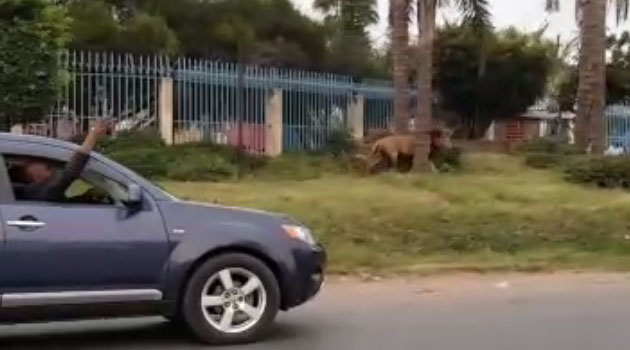
Sometimes the lions are killed by livestock farmers protecting their herds, other times they prowl leafy gardens giving residents a fright.
Lions, just like any other wildlife animal are precious for the country, but only when in its territory at the designated national parks.
In three incidents since February the king of the jungle’ has been sighted in the Kenyan capital, with the latest and worst incident occurring on Friday, when an elderly man was clawed by a male lion that was wandering along Mombasa Road during the morning rush hour.
In mid-February, two lions spent a day wandering through Kibera, a densely-packed city slum, before returning to the park, and days later more lions were spotted in town.
While lions on the loose are increasingly common in Nairobi, it is unusual for anyone to be injured during their outings.
Kenya Wildlife Service (KWS) spokesman Paul Udoto told Capital FM news that the 63-year-old man was injured when the lion became agitated and swiped at him, as curious onlookers moved closer to have a glimpse of it, with motorists honking their horns to scare it away.
The big cats are under growing pressure as one of Africa’s fastest growing cities expands onto ancient migration routes and hunting grounds, with conservationists and wildlife experts explaining that it is the people who have moved into the lions’ home ranges.
Lions are estimated to have declined in number by as much as three-quarters since 1980, and to occupy less than a tenth of their historic range across Africa.
“The infrastructural developments that have taken place within the parks are likely to affect the behavioral patterns of wildlife,” Paul Jinaro, the KWS Corporate Communications Officer told Capital News, ““This can be attributed to the ongoing developments that partly touch on the park as well as human encroachment.”
There is no doubt that Kenya’s iconic Nairobi National Park is under threat with the country weighing the difficult balance between conservation and development, being the only city in the world with a natural ancient park within.
Sometimes the lions are killed by livestock farmers protecting their herds, other times they prowl leafy gardens giving residents a fright.
Key wildlife corridor for animals moving to find grazing grounds, water have been destroyed owing to structures being put on their path way.
The developments encroaching into the park include roads, railway lines among other infrastructure projects lined up.
Conservationists say wildlife protection is a low priority for city officials struggling with multiple challenges in a grossly unequal capital of some 3.5 million people with overstretched basic services and infrastructure.
In Nairobi, lavish villas adjoin squalid slums and cramped high rise apartments.
“We know that there is growing concern by the public owing to the current sightings of lions in some parts of the city,” said Jinaro, adding “With the increase in population and most land around the park being robust with human activity, there is need for fencing as well as educate people on how to co-exist peacefully with the wild.”
Jinaro said they have lately intensified patrols around parks to curb incidents of lions prowling into human settlements, with efforts intensified to seek funds to construct a fence around the Nairobi national park.
Currently, the park is not entirely fenced to enable traditional migration by animals in search of grazing grounds.
Jinaro said KWS has also dedicated a whole division to deal with Human-Wild life Conflict (HWC) which is on a rapid increase.
HWC is one of the most critical threats facing many wildlife species today, and the topic is receiving increasing attention from conservationists.
The complexity in mitigation of human wildlife conflict is heightened by the increasing human population and the lack of information to aid in the development of more innovative HWC mitigation mechanisms.
This then results to lower community tolerance to wildlife leading, in most cases, to wildlife persecution.
To further shed light on the behavioral changes witnessed on wild animals especially lions, a research on impact of severe climate variability on lion home range and movement pattern by KWS shows that climate changes have affected the habitat quality, food supply and access which in turn influences the lion’s home range and movement patterns.
The research concludes that the severe climate condition creates new challenges to lion conservation such as prey availability.
This in turn forces the lions beyond current boundaries in to areas where there will be greater conflicts with humans.
Other than lack of fencing, encroachment by humans, Jinaro said that they will address adequately, other causes of lions straying out of the park.
Joe Nyamu, Director of Elephant Neighbors Center also noted that cases of lions or any other wild animals straying off parks are likely to increase if proper action is not taken.
“An electric fence should be erected in all parks bordering human settlements,” he said, “This should go hand in hand with a custom made program for the communities neighboring parks, to enlighten them on the need and importance of co-existing peacefully with the wild.”









































